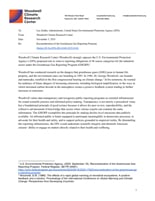Submitted comment on the Greenhouse Gas Reporting Program

On October 29, Woodwell Climate submitted public comment to the U.S. Environmental Protection Agency’s proposed amendments to the Greenhouse Gas Reporting Program (GHGRP).
Woodwell Climate Research Center (Woodwell) strongly opposes the U.S. Environmental Protection Agency’s (EPA) proposed rule to remove reporting obligations of 46 source categories for the industrial sector under the Greenhouse Gas Reporting Program (GHGRP).1
Woodwell has conducted research on the dangers that greenhouse gases (GHG) pose to human life, property, and the environment since our founding in 1985. In 1986, Dr. George Woodwell, our founder and namesake, testified in the first congressional hearing on climate change.2 In his testimony, he warned his audience of future dangers of increasing emissions, including biological amplification, or the ways in which increased carbon dioxide in the atmosphere creates a positive feedback system leading to further increases in emissions.
Woodwell values data transparency and recognizes public reporting programs as essential infrastructure for sound scientific practice and informed policy-making. Transparency is not merely a procedural virtue but a foundational principle of good science because it allows for peer review, reproducibility, and the collective advancement of knowledge that occurs when various experts can examine the same information. The GHGRP exemplifies this principle by making facility-level emissions data publicly available. An informed public is better equipped to participate meaningfully in democratic processes, to advocate for their health and safety, and to support policies grounded in empirical reality. By dismantling
this reporting infrastructure, the EPA would undermine scientific integrity and diminish American citizens’ ability to engage on matters directly related to their health and wellbeing.
Scientific Foundation and EPA’s Flawed Rationale for Rescission
Originally established in 2009, the GHGRP, under the Clean Air Act (CAA), required that the largest industrial emitters reported their emissions annually.3 EPA cited two sections of the CAA that provided authority to create the GHGRP, Sections 114 and 208. Section 114(a)(1) provides the basis for the EPA to require the monitoring and reporting of emissions, and section 208 provides EPA with the authority regarding motor vehicles and their engines.
Since then, the GHGRP has been used for monitoring emissions from 47 source categories, across 8,000 facilities in the United States.4 Efforts support our understanding of climate change as well as air quality, without such monitoring it will be difficult to track progress, or lack of progress, towards reducing emissions and may worsen health outcomes.5
Based on two broad sets of rationales, the EPA proposes to eliminate most of the GHGRP, removing reporting requirements for all source categories except petroleum and natural gas systems (Subpart W), which would be suspended until 2034. Under the proposed rule, EPA argues that Section 114 does not provide authority to collect GHGRP data because the reporting requirements do not serve an underlying statutory purpose under CAA. Specifically, EPA argues that Section 114 requires a greater connection between the continuous regulation obligation and a statutory purpose.6 Moreover, the agency argues that the elimination of most of the GHGRP will not disrupt its ability to meet provisions under the CAA and will not have any harm on human health or the environment.7 Such a claim ignores the substantial and mounting evidence that climate change and associated pollution significantly affect the health and welfare of American communities.
Health and Welfare Consequences
When established, the GHGRP was based upon a strong scientific foundation. Since the establishment of the GHGRP, the science supporting the effects of GHG emissions on public health and welfare has grown stronger, making accurate emissions monitoring more important than ever.
In 2023, the Fifth National Climate Assessment comprehensively assessed the current and future risks to the United States of GHG-induced climate change, including extensive evidence for public health impacts. The authors report existing harm to human health across the U.S. that is only expected to worsen with continued warming. The assessment documents compounding health hazards including: “More severe and frequent extreme events; Wider distribution of infections and vector-borne pathogens; Air quality worsened by smog, wildfire smoke, dust, and increased pollen; and threats to food and water security.”8 Rather than responding to this mounting evidence by strengthening emissions monitoring, the EPA proposes to eliminate the very reporting infrastructure needed to track and address these emission sources.
Threats to public health and welfare are further documented by international scientific assessments. The IPCC, established in 1988 by the United Nations Environment Program (UNEP) and the World Meteorological Organization (WMO), reviews existing scientific research on climate change and produces Assessment Reports that synthesize that knowledge. The IPCC’s Sixth Assessment Report draws upon peer-reviewed scientific literature to conclude with high confidence that climate change has already resulted in “destruction of homes and infrastructure, and loss of property and income, human health and food security.”9 The report documents observed impacts including “Infectious diseases; Displacement; Mental health; Heat, malnutrition and harm from wildfire”10 as widespread and substantial consequences of GHG emissions around the world. The IPCC specifically examines North America, finding with very high confidence that rising temperatures are projected to increase heat-related mortality across all emission scenarios this century, and that smoke from intensified wildfire activity is associated with respiratory distress, with impacts persisting long distances from wildfires and beyond initial high-exposure periods, further underscoring the urgency of maintaining comprehensive emissions data.11
The strengthened scientific evidence cited above makes clear that the GHGRP serves a vital public health function. Accurate emissions data enables researchers, policymakers, and communities to identify pollution sources, track trends, and develop targeted interventions to protect public health. Eliminating reporting requirements would create blind spots in our understanding of emissions sources at the same time as the health consequences of GHG emissions are becoming more severe and better documented.
Case Study: Air Quality & Monitoring
Woodwell’s research demonstrates the connection between air quality and climate change. Exposure to pollutants, such as ozone, nitrogen dioxide, carbon monoxide, sulfur dioxide, and particulate matter (PM), are contributors to a range of health issues.12 For example, PMs are microscopic particles that can penetrate deep into the body, exacerbating heart and lung disease, cancer, and cognitive problems.13,14 Scientists have also found long-term exposure to these pollutants can reduce life expectancy.15 These pollutants are often produced by the burning of fossil fuels, which also emits GHG emissions that drive climate warming. Climate change worsens pollution exposures by trapping pollutants in the atmosphere for longer periods of time, thereby increasing exposure durations and concentrations.16
In September 2025, the EPA released a report that found that intermittent air monitoring has adverse effects. Specifically, when air quality monitoring was offline for certain sites, those same sites saw a significant increase in air pollution levels.17 This report is consistent with what other scientists have found with intermittent monitoring of environmental standards and is known as the pollution gap.18 The pollution gap may lead to higher than allowable and unhealthy exposure, putting American communities at risk. The elimination of most of the GHGRP will only increase this threat.
Conclusion
The overwhelming scientific evidence is clear: GHG emissions pose a serious threat to public health and welfare that demands action, monitoring these emissions are essential for such action. Rescinding the GHGRP reporting obligation would be deeply contrary to the robust scientific evidence for the current and future harms to public health and welfare resulting from unfettered GHG emissions. Doing so would abandon America’s responsibility to protect its citizens and abdicate our leadership in addressing the defining challenge of our time. We urge the EPA to withdraw this proposed rule and instead strengthen efforts to monitor GHG emissions from all sources, including the industrial sector.









